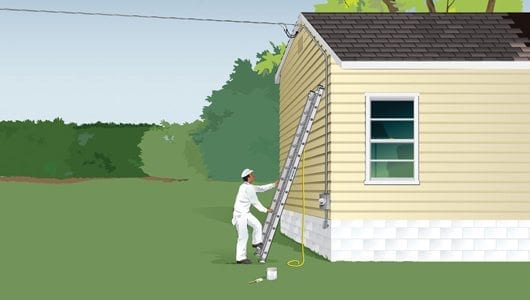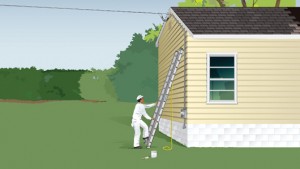
How to stay safe when working near electricity
Working near electricity is dangerous and can be deadly. Electricians, painters, laborers, carpenters, maintenance and repair workers, and other trades working near electricity are at risk. To protect yourself and your employees, learn to recognize, evaluate, and control hazards, such as overhead power lines, improper grounding, overloaded circuits and defective insulation.
Electricity travels in a closed circuit and if someone accidentally becomes part of the electric circuit, current flows through the body, which can result in electrical shock and burns. The severity of the shock depends on the amount of current flowing through the body, the path of the current flowing through the body, the length of time the body is in the circuit, the voltage, and the amount of moisture in the environment. Effects can range from a tingle to severe burns and cardiac arrest.
The hazards of working near electricity can be avoided by following the National Electrical Code, NFPA 70, and NFPA 70E Standard for Electrical Safety in the Workplace, developed by the National Fire Protection Association (NFPA). The Occupational Safety and Health Administration’s (OSHA) electrical standards are based on the NFPA standards.
Avoid overhead power lines
Touch an overhead power line with a ladder, scaffolding or a piece of equipment, and the result can be electrocution. On your jobsite survey, note the location of power lines and look for hidden power lines in trees. Equipment and materials should never come within 10 feet of power lines. Higher voltage lines require a distance of 18 feet. Consider ladder length and the area for ladder staging. Measure from the end of your extended reach and include the tip of any object you are carrying.
Never use metal ladders near energized overhead power lines or working near electricity; instead use ladders approved by the American National Standards Institute (ANSI). Always lower the ladder and carry it horizontally when moving it. Notify the local electric utility company for assistance if work needs to be done closer to energized, overhead power lines.
[tip id=”9147″]Assure proper grounding
The metal parts of an electrical wiring system that are touched – switch plates, ceiling light fixtures, conduit, etc. – should be grounded and at 0 volts. If there is no safe path to ground for fault currents, exposed metal parts in damaged appliances can become energized.
A ground fault circuit interrupter, or GFCI, protects against dangerous shocks by detecting any difference in current between the two circuit wires and switching off the current.
Watch out for missing, damaged, or improperly wired GFCIs and test GFCIs regularly. If the circuit does not turn off, the GFCI is faulty and must be replaced. Always plug portable power tools into a GFCI I-protected temporary power pole or a GFCI-protected generator, or use a GFCI extension cord.
Equipment also must be grounded if it is within 8 feet vertically and 5 feet horizontally of the floor; located in a wet or damp area and not isolated; or connected to a power supply by cord and plug and not double-insulated.
Avoid overloading circuits
When too many devices are plugged into a circuit, wires can heat up. An over current protection device such as a circuit breaker or fuse prevents this by immediately opening the circuit if it detects current in excess of the current rating for the equipment or wiring. This excess current can also be caused by a short circuit or malfunctioning equipment. Investigate the cause and fix the problem before continuing work.
Use the right wire
If the wire gauge is too small for the current it is supposed to carry, it will heat up, creating an electrical hazard. Prevent an overload by selecting the right size and type of wire, with insulation appropriate for the voltage and environment. Check wire insulation for damage; exposed metal parts can become energized if a live wire touches them.
If an extension cord is used, choose one with sufficient capacity for the tool being used. An undersized cord can overheat and cause a drop in voltage and tool power. Inspect the insulation of extension cords for damage; a short could easily cause arcing and a fire. Never use a cord that feels hot or is damaged in any way. Use only three-wire type extension cords designed for hard or junior hard service (marked with an S on the casing).
Always de-energize circuits
Always turn off circuits you will be working on and test them before beginning work. Make certain all energy sources are locked out and tagged out before performing any work on an electrical circuit or electrical device. Even low voltage circuits must be turned off at the switch box and padlocked in the off position.
Use and maintain tools properly
NFPA 70E requires that those working near electricity use insulated tools within the limited approach boundary. Inspect tools for cracked casings, dents, missing or broken parts, and contamination. Damaged tools must be removed from service and properly tagged.
Power tools with metal housings or only one layer of effective insulation must have a third ground wire and three-prong plug. Double-insulated tools with two insulation barriers and no exposed metal parts offer shock protection without the need for a third ground.
Use personal protective equipment
NFPA70E requires personal protective equipment such as rubber gloves, insulating shoes or boots, face shields, safety glasses, and hard hats, depending on the type of electrical hazard.
ANSI approved footwear appropriate for electrical hazards will be marked EH. Hard hats approved for electrical work made since 1997 are marked “Class E.” Safety glasses with side shields or goggles should be stamped with Z87 to show they are ANSI-certified.
Arc blasts and burns
Currents above 10 mA can paralyze muscles so a person is no longer able to release a tool, wire or other object. Burns caused by electricity include electrical burns, arc burns and thermal contact burns. Electrical burns can result when a person touches electrical wiring or equipment that is used or main¬tained improperly. Arc burns are the result of an arc-blast, a condition that occurs when powerful, high-amperage voltages exist across a gap between conductors and current travels through the air, producing a luminous electrical discharge and temperatures up to 30,000 degrees F. Thermal burns can result when electricity ignites an explosive mixture of material in the air. This ignition can result from the buildup of combustible vapors, gases, or dusts.
Shock approach boundaries
Three shock approach boundaries (limited, restricted and prohibited) are defined by NFPA 70E.
- A limited approach boundary should only be crossed by qualified persons (at a distance from a live part). It should not be crossed by unqualified persons unless escorted by a qualified person.
- A restricted approach boundary should only be crossed by qualified persons (at a distance from a live part). Due to its proximity to a shock hazard, it requires the use of shock protection techniques and equipment when crossed.
- A prohibited approach boundary should only be crossed by qualified persons (at a distance from a live part). When crossed by a body part or object, it requires the same protection as if direct contact is made with a live part.
OSHA’s 29 CFR 1910 Subpart S defines a qualified person as one who has been trained to recognize and avoid electrical hazards when working on or near exposed energized parts and has the authority to stop the work if necessary.


